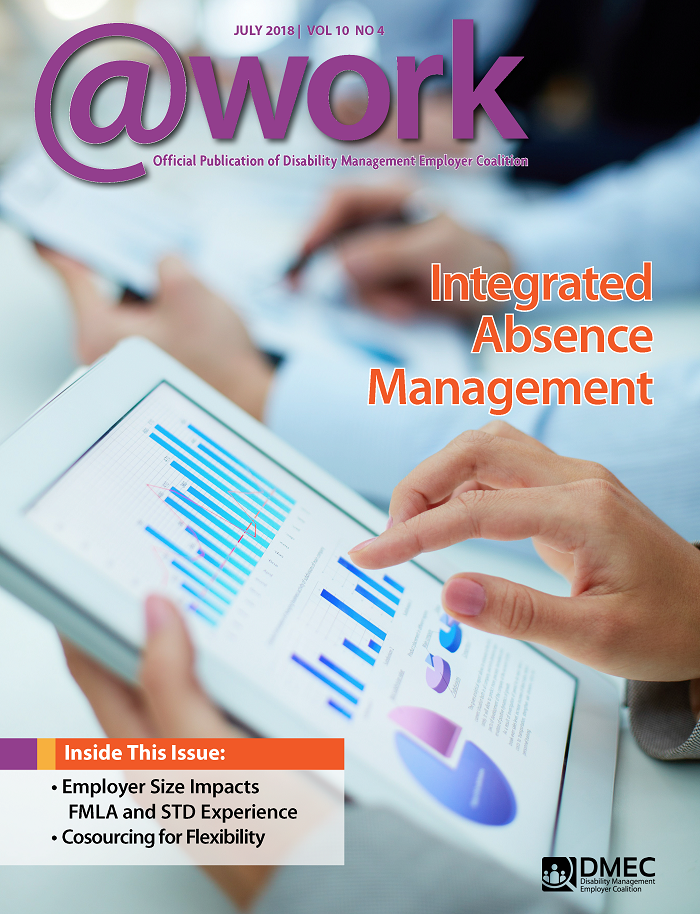
July 2018
Integrated Absence Management
The use of data analytics has the ability to drive fundamental change in your integrated absence management programs; however, it needs to be infused in an organization's architecture from end to end to create a holistic approach. This issue features case studies and examples of how you can put data to work in your organization to effectively shape your absence and well-being strategies.
Features
Impact of Employer Size on Absence and Disability
After analyzing the most recent data and studies, significant differences were found in short-term disability and Family and Medical Leave Act incidence, duration, and cost based upon employer size. Generally, larger employers face higher costs, incidence, and duration per employee than do smaller employers. Read more.

Cosourcing: The Right Vendor Partnership Increases Employer Flexibility
Employers often face a leave management conflict when considering outsourcing: the complexities make outsourcing attractive, but employers can’t outsource legal responsibility for decisions affecting their workforce. “Cosourcing” is a third option that may provide the right balance for some employers. Read more.

Spotlight Articles
Program Showcase: Vendor Selection
In response to rapid changes, employers have turned to outsourcing absence management to leverage the expertise and technology that vendor partners offer and create more effective absence management solutions. Here are 14 questions to ask as you consider vendor partners. Read more.

RTW Case Study: Impact of Employer Size
A review of mental health and musculoskeletal short-term disability claims add detail and depth to the surprising relationship between employer size and short-term disability experience. These findings have important implications for employers. Read more.

Compliance Makeover: Developing Data Intelligence
We have all seen claims that ended up with unexpectedly poor return-to-work outcomes, and wanted to know why. A recent pilot project revealed interesting differences between claims with good or poor return-to-work outcomes and how employers can use the information to improve their programs. Read more.

Columns
Work/Life Squeeze: Title VII Family Responsibility Discrimination
Title VII of the Civil Rights Act of 1964 provides employment protections against discrimination on such bases as race, religion, national origin, and sex (and pregnancy). But most employers don’t realize Title VII also protects workers who are caregivers against “family responsibility discrimination”. Read more.

Integrated Absence Management: Cancer and Disability
A diagnosis of cancer was once the beginning of the end for many people. Now more than two-thirds of these survivors are able to return to work, but they often face significant challenges. A few programs have been developed to improve return-to-work outcomes for cancer patients. Read more.

Absence Matters: Healthy Conversations
As organizations look to increase productivity, protect and care for their employee populations, and create a more meaningful work experience, this is an ideal time for risk managers to talk with their peers in disability and absence management to explore the possible advantages of combining the best elements of both worlds. Read more.

Engaging Today's Workforce: Flexible, Enhanced Leave and Disability Programs
During a period of record-low unemployment, it can be difficult to replace employees. But a well-managed, tailored disability management program can lessen this burden by helping employees return to work sooner through transitional work and other programs. Read more.

The Disabled Workforce: Psychological Disabilities, the ADA, and the Stressed-Out Worker
One in four American adults experiences mental health problems in any given year, with employees suffering from depression alone reporting the equivalent of 27 missed work days per year. Every employer can reduce the negative impact of mental illness in three areas. Read more.

Innovations Enhance Outcomes: Total Employee Health
Integrated absence management is more than just a process to coordinate or integrate employee benefits. Truly helping employees prevent disability, stay at work, or return to work requires an understanding of the forces impacting an individual’s health or illness. Read more.

Accommodations Best Practice Guide: Early Return to Work
We know absenteeism results in lost productivity, whereas return to work is a “win-win" for employers and employees alike. Yet many employers have struggled to move past “talking the talk” to actually implementing successful programs. Read more.

Riding the Demographic Wave: “Xennials” and the Gig Worker Movement
The number of gig workers is increasing, and the gig economy seems to be booming. As employers increase their utilization of the gig economy, they will need new disability, absence, and benefit solutions to support this fast-evolving segment of the workforce. Read more.

6 Pillars of Leave Management: Peripheral Vision
With enough information, you can be more strategic in your approach to absence management. But how do you structure your absence management program and systems to capture the necessary data to identify trends, illuminate strengths, pinpoint compliance risk, and get the most out of your workforce? Peripheral vision is key. Read more.

Aligning Workers' Compensation: WC Indemnity Claims & LTD
What happens when longer-duration WC claims overlap with LTD? A few simple processes can help your LTD carrier and administrator or carrier for workers' compensation coordinate to substantially reduce hassles and delays, while setting the stage for a better-than-average resolution of the dual claim. Read more.

Departments
The CEO's Desk: Knowing the Numbers
With the theme of integrated absence management, it’s no accident that data is at the heart of nearly all the feature and spotlight articles in this issue. When you understand “the numbers”, you can identify the important issues impacting your workforce. Only then can you shape your absence and well-being strategies effectively. Read more.

DMEC News: July 2018
In this issue of DMEC News, we discuss three leave trends that came out of the sessions at the 2018 DMEC FMLA/ADA Employer Compliance Conference and highlight several new free opioid resources for employers. Read more.

Compliance Memos: July 2018
The July 2018 compliance memos cover new paid sick leave laws in the U.S., a 9th circuit ruling around equal pay, and new administrative rules for Washington's Paid Family and Medical Leave law. Read more.




